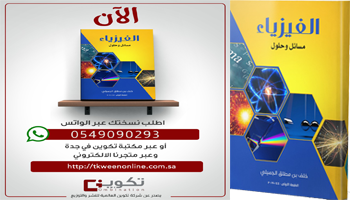أهلا وسهلا بك إلى ملتقى الفيزيائيين العرب.
أهلا وسهلا بك زائرنا الكريم، إذا كانت هذه زيارتك الأولى للمنتدى، فيرجى التكرم بزيارة صفحة التعليمـــات، بالضغط هنا.
كما يشرفنا أن تقوم بالتسجيل بالضغط هنا إذا رغبت بالمشاركة في المنتدى، أما إذا رغبت بقراءة المواضيع والإطلاع فتفضل بزيارة القسم الذي ترغب أدناه.
| ملتقى الفيزيائيين العرب > قسم المناهج الدراسية > فيزياء المرحلة الجامعية. | ||
| General Physics for Medical Sciences Students | ||
| الملاحظات |
|
|
أدوات الموضوع | انواع عرض الموضوع |
|
#1
|
|||
|
|||
|
General Physics for Medical Sciences Students
By Dr. Hasan Maridi 1st edition, 2017 كتاب الفيزياء العامة لطلاب الكليات الطبية للدكتور حسن مريدي لتحميل الكتاب اضغط الرابط https://drive.google.com/open?id=0B4...XBYQllJRnpxaVE References 1-Physics for Scientists and Engineers (with PhysicsNOW and InfoTrac), Raymond A. Serway - Emeritus, James Madison University , Thomson Brooks/Cole © 2004, 6th Edition, 1296 pages. 2- Power point slides of Serway book (Physics for Scientists and Engineers) from Cengage Learning Company (http://www.cengage.com). 3- Medical physics, John R .Cameron. 4- Medical Physics, Hazem Sakeek, 2014 5- Dr. Taima lectures in medical physics, University of Mosul 6- Lectures in General Physics1, Mechanics, HazeemSakeek, 2001 Contents Chapter 1 Physics and Measurement 1.1 Standards of Length, Mass, and Time 1.2 Matter and Model Building 1.3 Dimensional Analysis 1.4 Conversion of Units 1.5 Medical Physics Chapter 2 Vectors 2.1 Coordinate Systems 2.2 Vector and Scalar Quantities 2.3 Some Properties of Vectors 2.4 Components of a Vector and Unit Vectors 2.4 Scalar Product of Vectors Chapter 3 The Force and Laws of Motion 3.1 The Concept of Force 3.2 Newton’s First Law 3.3 Mass 3.4 Newton’s Second Law 3.5 The Gravitational Force and Weight 3.6 Newton’s Third Law 3.7 Forces of Friction 3.8 Forces in and on the body Chapter 4 Static Equilibrium and Elasticity 4.1 The Rigid Object in Equilibrium 4.2 More on the Center of Gravity 4.3 Examples of Rigid Objects in Static Equilibrium 4.4 Elastic Properties of Solids 4.5 Stress, Strain, and Elasticity Modulus Chapter 5 Energy and its Conservation 5.1 Systems and Environments 5.2 Work Done by a Constant Force 5.3 Kinetic Energy and the Work–Kinetic Energy Theorem 5.4 Potential Energy of a System 5.5 Conservative and Nonconservative Forces 5.6 Energy Diagrams and Equilibrium of a System 5.7 The Isolated System 5.8 Power 5.9 Energy Changes in the body 5.10 Metabolic rate 5.11 Efficiency of the Human body Chapter 6 Fluid Mechanics 6.1 Fluid Properties 6.2 Viscosity 6.3 Surface Tension, Capillary 6.4 Pressure, Variation of Pressure with Depth 6.5 Pressure Measurements 6.6 Measurement of blood pressure. 6.7 Buoyant Forces and Archimedes’s Principle 6.8 Fluid Dynamics 6.9 Bernoulli’s Equation and its Applications 6.10 Effect of gravitational forces on human body. Chapter 7 Temperature and Thermodynamics 7.1 Temperature and the Zeroth Law of Thermodynamics 7.2 Thermometers and the Celsius Temperature Scale 7.3 The Absolute Temperature Scale 7.4 Thermal Expansion of Solids and Liquids 7.5 An Ideal Gas 7.6 Heat and Internal Energy 7.7 Specific Heat and Calorimetry 7.8 Work and Heat 7.9 The First Law of Thermodynamics 7.10 Energy Transfer Mechanisms 7.11 Heat losses from the body Chapter 8 Sound Wave 8.1 Propagation of a Disturbance 8.2 The Traveling Wave Model 8.4 Sound Waves, Speed and Intensity of Sound Waves 8.5 Sound Level 8.6 The Doppler Effect 8.7 Shock Waves 8.8 Ultrasound and Medical Applications 8.9 A Scan, B Scan, M Scan Chapter 9 Light and Image Formation Optics 9.1 The Nature of Light 9.2 The Ray Approximation 9.3 The Light Reflection 9.4 The Light Refraction 9.5 The Rainbow, Fiber Optics 9.6 Medical uses, Endoscope 9.7 Images Formed by Thin Lenses 9.8 Optical Instruments: The Simple Magnifier, The Compound Microscope 9.9 The Eye, Myopia, Hyperemia Chapter 10 Electric Fields 10.1 Properties of Electric Charges 10.2 Coulomb’s Law 10.3 The Electric Field 10.4 Electric Potential and Potential Difference 10.5 Capacitance, Combinations of Capacitors, Capacitors with Dielectrics 10.6 Electric Current 10.7 Resistance, Resistance and Temperature, Resistors in Series and Parallel 10.8 Superconductors 10.9 Electric Power 10.10 Electrical Safety 10.11 Electricity Within the Body 10.12 Electromyography (EMG) 10.13 Electrocardiograph (ECG) 10.14 Electroencephalograph (EEG) Chapter 11 Nuclear Physics and its Applications, Radioactivity 11.1 Some Properties of Nuclei 11.2 Nuclear Binding Energy 11.3 Radioactivity 11.4 The Decay Processes 11.5 Natural Radioactivity 11.6 Nuclear Reactions 11.7 Nuclear Magnetic Resonance and Magnetic Resonance Imaging 11.8 Nuclear Fission, Nuclear Reactors, Nuclear Fusion 11.9 Radiation Damage 11.10 Radiation Detectors 11.11 Uses of Radiation |
«
الموضوع السابق
|
الموضوع التالي
»
| الذين يشاهدون محتوى الموضوع الآن : 2 ( الأعضاء 0 والزوار 2) | |
| انواع عرض الموضوع |
 الانتقال إلى العرض العادي الانتقال إلى العرض العادي |
 الانتقال إلى العرض المتطور الانتقال إلى العرض المتطور |
 العرض الشجري العرض الشجري |
|
|
المواضيع والمشاركات المنشورة لا تعبر عن رأي ملتقى الفيزيائيين العرب ولانتحمل أي مسؤولية قانونية حيال ذلك ويتحمل كاتبها مسؤولية النشر"
الساعة الآن 21:34





